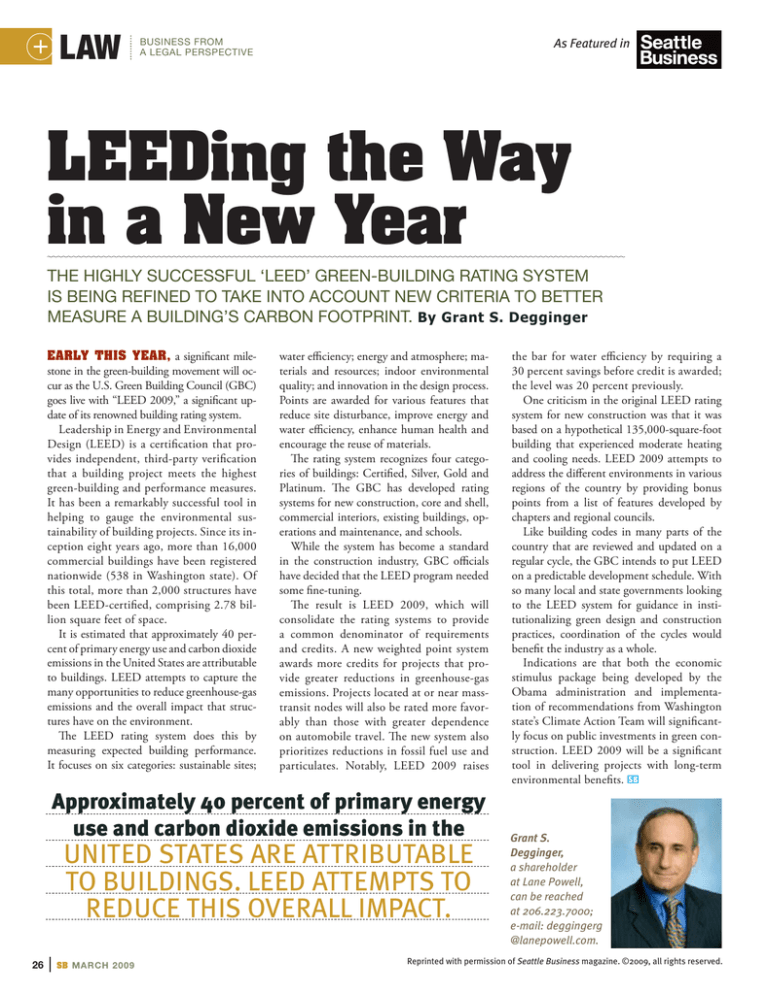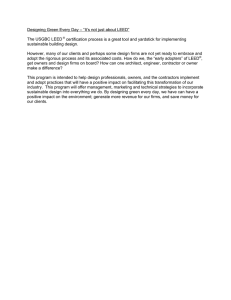law
advertisement

law As Featured in business from a legal perspective LEEDing the Way in a New Year The highly successful ‘LEED’ green-building rating system is being refined to take into account new criteria to better measure a building’s carbon footprint. By Grant S. Degginger Early this year, a significant milestone in the green-building movement will occur as the U.S. Green Building Council (GBC) goes live with “LEED 2009,” a significant update of its renowned building rating system. Leadership in Energy and Environmental Design (LEED) is a certification that provides independent, third-party verification that a building project meets the highest green-building and performance measures. It has been a remarkably successful tool in helping to gauge the environmental sustainability of building projects. Since its inception eight years ago, more than 16,000 commercial buildings have been registered nationwide (538 in Washington state). Of this total, more than 2,000 structures have been LEED-certified, comprising 2.78 billion square feet of space. It is estimated that approximately 40 percent of primary energy use and carbon dioxide emissions in the United States are attributable to buildings. LEED attempts to capture the many opportunities to reduce greenhouse-gas emissions and the overall impact that structures have on the environment. The LEED rating system does this by measuring expected building performance. It focuses on six categories: sustainable sites; water efficiency; energy and atmosphere; materials and resources; indoor environmental quality; and innovation in the design process. Points are awarded for various features that reduce site disturbance, improve energy and water efficiency, enhance human health and encourage the reuse of materials. The rating system recognizes four categories of buildings: Certified, Silver, Gold and Platinum. The GBC has developed rating systems for new construction, core and shell, commercial interiors, existing buildings, operations and maintenance, and schools. While the system has become a standard in the construction industry, GBC officials have decided that the LEED program needed some fine-tuning. The result is LEED 2009, which will consolidate the rating systems to provide a common denominator of requirements and credits. A new weighted point system awards more credits for projects that provide greater reductions in greenhouse-gas emissions. Projects located at or near masstransit nodes will also be rated more favorably than those with greater dependence on automobile travel. The new system also prioritizes reductions in fossil fuel use and particulates. Notably, LEED 2009 raises Approximately 40 percent of primary energy use and carbon dioxide emissions in the united states are attributable to buildings. LEED attempts to reduce this overall impact. 26 SB march 2009 the bar for water efficiency by requiring a 30 percent savings before credit is awarded; the level was 20 percent previously. One criticism in the original LEED rating system for new construction was that it was based on a hypothetical 135,000-square-foot building that experienced moderate heating and cooling needs. LEED 2009 attempts to address the different environments in various regions of the country by providing bonus points from a list of features developed by chapters and regional councils. Like building codes in many parts of the country that are reviewed and updated on a regular cycle, the GBC intends to put LEED on a predictable development schedule. With so many local and state governments looking to the LEED system for guidance in institutionalizing green design and construction practices, coordination of the cycles would benefit the industry as a whole. Indications are that both the economic stimulus package being developed by the Obama administration and implementation of recommendations from Washington state’s Climate Action Team will significantly focus on public investments in green construction. LEED 2009 will be a significant tool in delivering projects with long-term environmental benefits. Grant S. Degginger, a shareholder at Lane Powell, can be reached at 206.223.7000; e-mail: deggingerg @lanepowell.com. Reprinted with permission of Seattle Business magazine. ©2009, all rights reserved.






